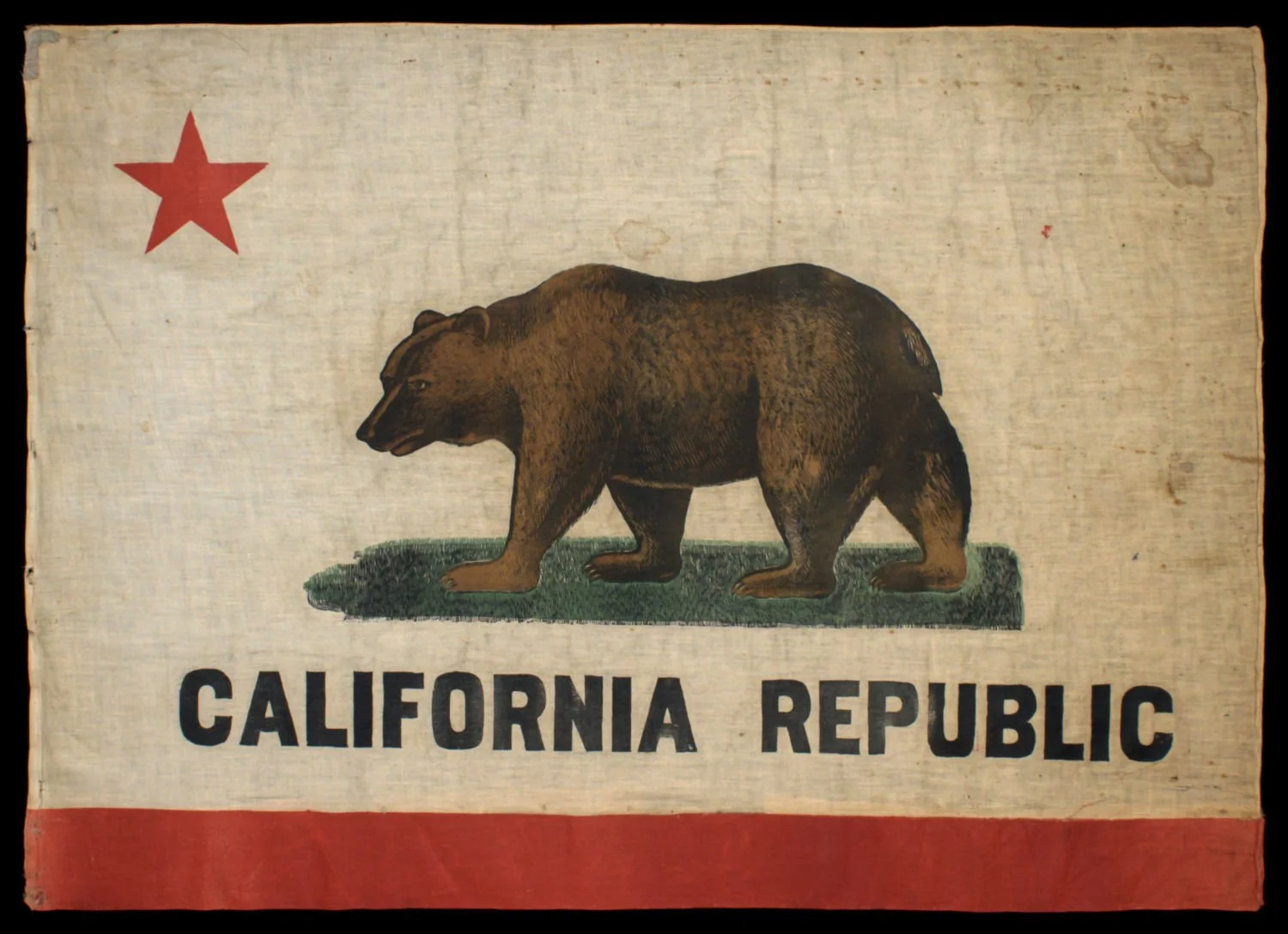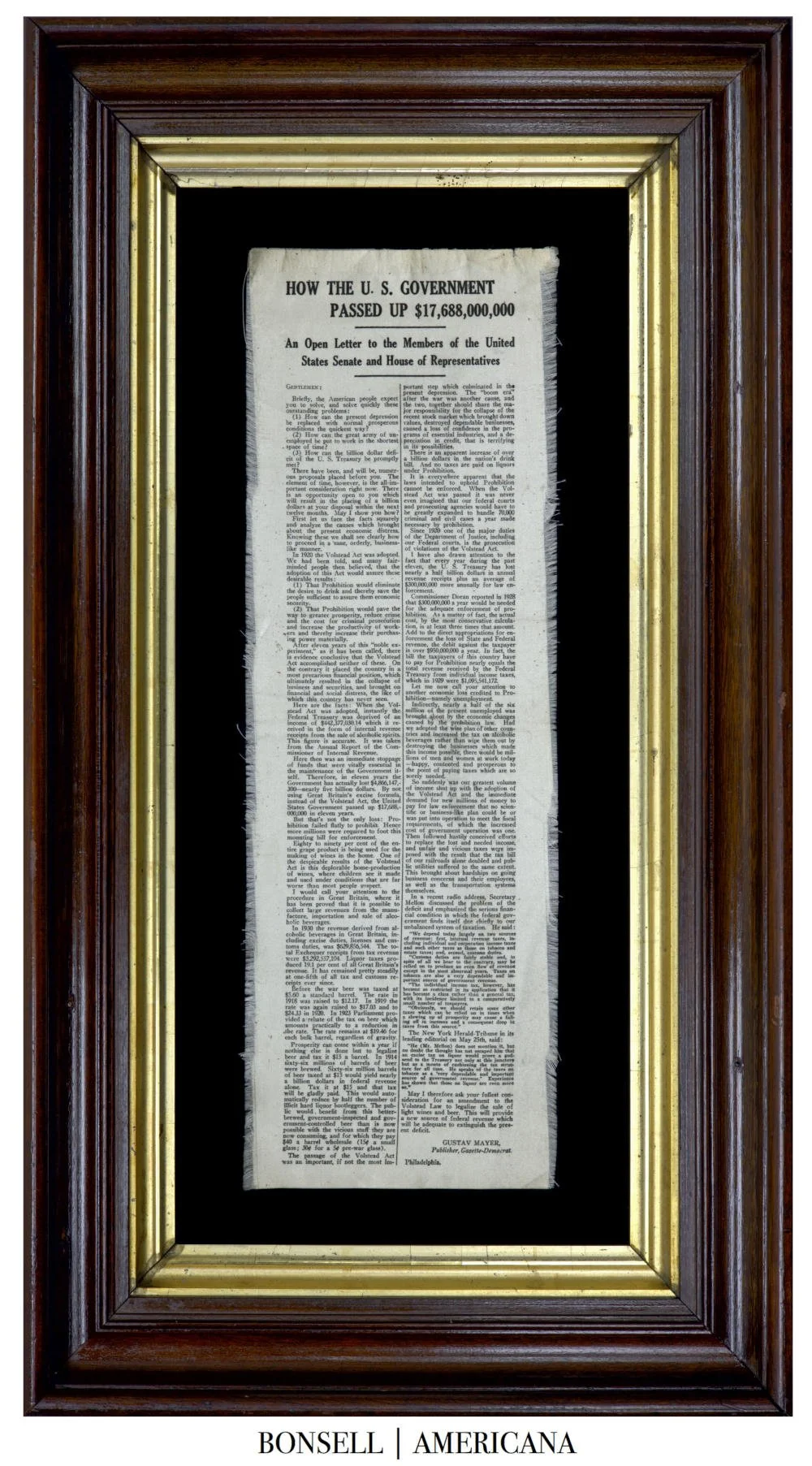Highly Desirable Antique California Bear Flag | Exceptional Form and Presence | Circa 1890-1911
Highly Desirable Antique California Bear Flag | Exceptional Form and Presence | Circa 1890-1911
Price: Call 618-553-2291, or email info@bonsellamericana.com
Frame Size (H x L): 22.5” x 35”
Flag Size (H x L): 33.5” x 46”
Offered is an antique California Bear Flag made of cotton, featuring the iconic design elements of early representations of the state's emblem. The flag displays a boldly printed grizzly bear walking on a patch of green grass, detailed with rich brown tones and dark shading. Positioned in the upper left corner is a red five-pointed star, a defining feature of the original Bear Flag design. Below the bear, the words "CALIFORNIA REPUBLIC" appear in bold, black capital letters, set in a straightforward block-style font. A wide red horizontal stripe spans the full width along the bottom, providing a contrast to the lighter cotton background.
We find this to be an especially strong example, even compared to others from the era, as the bear is well-rendered with more depth and character than typically seen in early versions. It is detailed, with visible fur texture and distinct claws. While well-executed, it still retains a somewhat crude and antiquated appearance, reinforcing its historical authenticity. This contrasts with modern California state flags, where the bear is more stylized and uniform in its proportions.
The origins of the California Bear Flag trace back to the Bear Flag Revolt of 1846, when a small group of American ranchers and adventurers, including William L. Todd—cousin of Mary Todd Lincoln—captured the city of Sonoma from Mexican forces and declared California an independent republic. The group designed its flag with a star, a bear, a red stripe, and the words "California Republic" emblazoned across its field. The inspiration for the star came from the 1836 California Lone Star Flag, while the bear was chosen as a symbol of strength and resistance.
In a letter written by Todd, he described how the red stripe was made from a strip of flannel taken from a petticoat worn across the mountains. The bear and star were painted with linseed oil and Venetian red, and the words “California Republic” were written in ink. This original flag flew briefly before being replaced by the American flag when U.S. forces took control of California. The first Bear Flag was preserved at the Society’s Pioneer Halls in San Francisco until it was lost in the fires following the great San Francisco earthquake of 1906.
This flag predates the full standardization of the California state flag in 1911, placing it firmly in the late 19th to early 20th century. Finding early state flags is difficult, as most states did not adopt official flags until the late 19th century, with many not finalizing their designs until after World War I. While the precise origin of this example is unknown, it may have been flown at the Columbian Exposition in Chicago in 1893, an event celebrating the 400th anniversary of Columbus’s voyage where state participation was a major aspect.
Alternatively, it could have been produced for later world’s fairs and expositions, such as the Pan-American Exposition in Buffalo in 1901, the Louisiana Purchase Exposition in St. Louis in 1904, or the Alaska-Yukon-Pacific Exposition in Seattle in 1909. Another possibility is that it was made to commemorate the 50th anniversary of California’s statehood in 1900 or in recognition of the official adoption of the California state flag in 1911. Whatever its purpose, this is one of the earliest California state flags we have offered.
The bear on the modern flag is based on Monarch, a real grizzly bear captured in the late 19th century and displayed in San Francisco’s Golden Gate Park. Monarch became a living symbol of California until his passing, after which he was mounted and remains on display at the California Academy of Sciences. Despite the extinction of the California grizzly in the early 20th century, Monarch’s image continues to represent the state’s independent and pioneering spirit.
The size of this flag, as presented in its frame, makes it especially desirable. It is large enough to command attention and make a statement, yet remains a manageable size for display in a home, office, or institutional setting. The proportions are well-balanced, allowing the details of the bear, star, and lettering to be fully appreciated without overwhelming the space in which it is placed.
Compared to others from the same timeframe, we believe this example has a particularly strong visual presence, with a bear that feels both lifelike and symbolic. Few antique state flags offer such a well-preserved combination of historical significance, artistic detail, and display-ready appeal.
Conservation Process: This flag was hand sewn to cotton fabric, and both were hand sewn to a mounting board. To prevent the black dye in the cotton fabric from seeping into the flag, it was first washed in a standard wash and then in a dye setting wash. The flag is positioned behind Optium Museum Acrylic.
Frame: The flag is housed in a high-quality black frame with a sleek, slightly beveled profile that adds a refined and professional presentation.
Condition Report: The cotton fabric exhibits some minor discoloration, light staining, and gentle fading, particularly in the red elements, which is typical of flags from this era. There are no significant losses or structural damage, and the lithographed bear remains bold and well-defined, making this an outstanding early example with strong visual appeal.
Collectability Level: The Best – Perfect for Advanced Collectors
Date of Origin: 1890-1911











